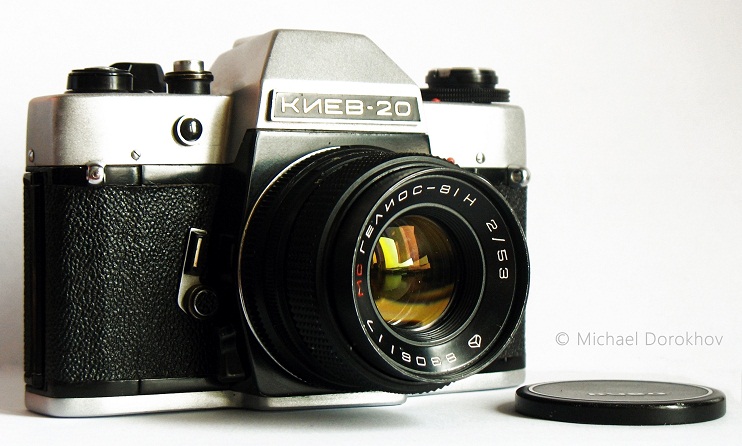"Kiev-20" - the flagship of Ukrainian photographic

So, in this article we will talk about the Kiev-20 film camera, we will also dive a little into the history of its creation, and of course, without a description and technical characteristics.
A bit of history
So, the Kiev plant "Arsenal" , which received reparations after the Second World War machines and drawings from the factories of the company Zeiss Ikon, starts the production of cameras (at the beginning of exact copies of the German Contax, and then its own design). By 1965, the production of mirror devices began. The first, and by the way, very daring models with their own bayonet (attaching the lens to the camera) appear: Kiev-10 (the world's first DSLR with a gun, Pentax Electro Spotmatic came out only after 6 years) and Kiev-15 .
')
Then, the following happened. On the occasion of the Olympic Games of the 80th year, the party leadership purchased a large number of Japanese equipment from Nikon (which at that time was considered the best and was carefully imported for the best Soviet photographers). The cost of buying foreign-made cameras prompted managers to release an own-produced professional SLR camera with a Nikon bayonet (for compatibility of lenses and cameras). For the start of production, the plant "Arsenal" was chosen, where there was already experience in creating SLR cameras. This marked the beginning of the creation on Arsenal of a line of cameras with the F bayonet , the standard Nikon's bayonet, which they called the Union in the Union - the N (Nikon) bayonet.
It was first developed Kiev-17 (purely mechanical, without an exposure meter), and then - Kiev-20 . The next model, called Kiev-19 , became a simplified version of the 20th.
Description
The camera is equipped with a built-in paired TTL-light meter. This means that you can simply set the aperture of the aperture on the lens, and rotate the shutter speed ring until the middle LED lights up in the viewfinder, which is responsible for the normal exposure (the top one is over exposure, the bottom one, respectively, is insufficient). It eats the whole thing from four LR44 batteries (such as laser pointers are used). However, the shutter is completely mechanical, i.e. no batteries are required for it. The aperture here is so-called “jumping”, which means that it closes to the working value only at the moment of shooting, and at the time of focusing remains open, which makes the process of focusing much more pleasant and easier (with an open aperture, the sharpness is better and blur in the viewfinder).

The camera has a focal lamella (lamellae - metal curtains) shutter with vertical movement of the lamellae. This gate, at one time, was created from scratch for Kiev-17, and by the time Kiev-20 was released, its production was streamlined and run-in. It clicks loudly, but not with a clanging, as at Zenith, it is probably the merit of more perfect mirror mechanics. This shutter was used only in the 17th and 20th Kiev.
The main thing is that Nikonovsky has a bayonet! This means that you can attach lenses from Nikon cameras to it or attach lenses produced by the Arsenal factory to your Nikon. And this is especially good, taking into account today's prices for lenses. True, you will have to pay with autofocus - of course, it will not work on shovel lenses. But their drawing is worth it .
The range of shutter speeds at the device is decent - from 1 second to 1/1000, which cannot be compared with the "classic" set of Zeniths (1/30 - 1/500).

Pleases field of view in the viewfinder - 93% of the frame! This is comparable to many modern digital SLRs (they usually have this figure of 95%). And it certainly does not compare with 63% of the same "classic" Zenith.
Also, the camera has a self-timer mode, aperture repeater (you can see at any time how the image will look with the aperture closed to the working value) and the multiple exposure mode (frame overlap).
Kiev-20 is filled with conventional film of type 135 (35 mm film)

Standard lens - Helios-81N. Excellent fifty dollars, or portrait painter, if you attach it to the Nikon. However, there are different objekiv for Kiev-20, such as this zoom:

Specifications
Let's summarize a little:
- Shutter with shutter speeds of 1 - 1 / 1000s and "B" (by hand)
- Viewfinder with full field of sight (viewfinder field - 23x35mm - 93% of the frame)
- Attaching the optics: bayonet H (geometrically compatible with Nikon F bayonet).
- Photosensitivity of the film: from 8 to 1000 units according to GOST.
- Self-timer
- Multiple exposure
- Overall dimensions: 90 x 96 x 145 mm
- Weight: 1100 g
- Years of release: 1983-1986
- The manufacturer: factory "Arsenal".
So why the flagship?
Of course, there were projects and more advanced cameras on the territory of the USSR, such as the Almaz , several Zenit models (although I agree, a couple of Zenits are close to it in terms of characteristics, but we are talking about the Ukrainian photo industry) and even “Kiev” prepared a serious receiver - Kiev-18 . But it so happened that the lack of funding for the photo industry in the 80s and then the collapse of the Union did not allow these projects to become a reality, and they remained in the form of prototypes that did not go into series. And Kiev-20 was released and quite realistically produced from 1983 to 1986. And I still take pictures of him.
Examples of pictures can be found here .
Source: https://habr.com/ru/post/135673/
All Articles